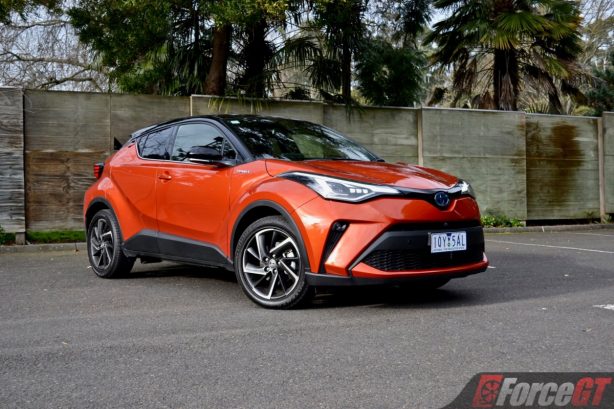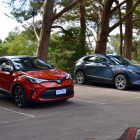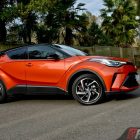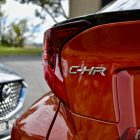The fast-growing compact crossover segment presents buyers with no fewer than 8 options. And if you have reached the point where you are tossing between the Mazda CX-30 and Toyota C-HR, congratulations because this pair plays at the top of the class. Which is best? That’s what we are about to find out.
Range and pricing
The CX-30 is the newer of the two, introduced earlier this year to bridge the gap between Mazda’s city-size CX-3 crossover and the medium CX-5 SUV. Based on the Mazda3 platform, the CX-30 is available in front- or all-wheel drive forms, with price ranging from $29,990 to $43,490 before on-road costs. The line-up spans a massive 13 variants and comprises three engine options. We tested the range-topping CX-30 G25 Astina AWD.
Toyota’s C-HR is a couple of years older but had recently undergone a nip and tuck to maintain appeal. Riding on the Toyota TNGA-C platform which underpins everything from the Prius to Lexus UX, the C-HR is positioned below the RAV4 as Toyota’s smallest SUV. That will soon change though with the forthcoming arrival of the Corolla Cross and Yaris Cross (in between which the C-HR is expected to slot).
The C-HR’s line-up has been recently simplified to just two variants – an entry-level GXL and a top-spec hybrid only Koba. All-wheel drive options have been dropped, leaving just front-wheel drive models available. Priced at $37,190 plus on-road costs, the C-HR Koba hybrid tested here has a significant $6,000 price advantage over the CX-30 from the outset, but is that enough to earn it victory? If only it’s that easy…
On the outside
The CX-30 is an interesting proposition. It’s got a mainstream badge but that’s all that is mainstream about it. The styling is one of premium undertaking – classy and restrained with a high level of detail. Not surprising because the donor design is the Mazda3 which itself is a standout in class.
Mazda’s Kodo design theme lends the CX-30 a beautifully sculpted design with intrinsic detailing around the fascia and taillights.
The thick wheel arch mounding may be a little too much for some but overall it’s easily passable as an upmarket offering.
The range-topping Astina grade rolls on 18-inch wheels and features LED exterior lighting all-around.
Recent update sees the C-HR scoring revised headlight and taillight cluster design, as well as new style front bumper. The updates are subtle so you will need a pair of well-trained eyes to pick out the changes.
The C-HR’s design is from a completely different spectrum to that of the CX-30. While the Mazda is elegant and understated, the Toyota is adventurous and out-there. Characterised by bold lines, sharp creases and a ‘floating’ roof, the C-HR has not a dull angle.
Like the CX-30 Astina, the C-HR Koba top-spec variant rides on 18-inch wheels and features full LED exterior lighting.
On the inside
The CX-30’s premium design language carries through to the interior. Carried over nearly unchanged from the Mazda3, the interior oozes quality and sophistication that you don’t expect to get in a mainstream segment. In fact, such expensive is the cabin feel that if it wasn’t for the badge you’d be led to believe you are in a luxury car.
Materials are first rate, with those gloss black trim deep and rich (and a magnet for fingerprints), and the leather upholstery superbly fine and soft. The white leather option on our tester may not be the most practical but boy does it look exquisite.
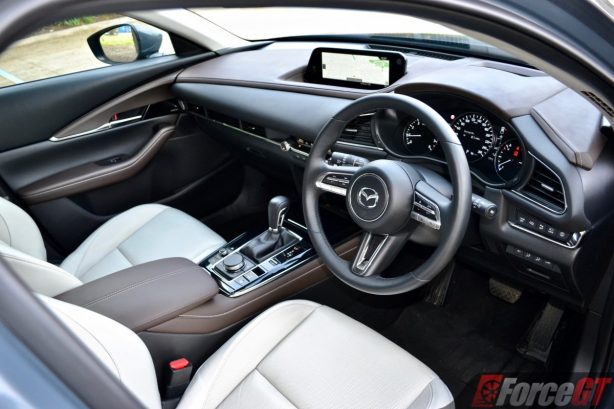
The C-HR’s interior is by no means bad, but in the company of the CX-30 it does feel rather ordinary. Granted, with more hard surfaces around the door cards and centre console it feels like it’s built more for durability and abuse than lush and luxury.
And while the seats in the Mazda look the business, it’s the C-HR front pews that feel more comfortable and better contoured to your body. Both top-spec crossovers feature heated front seats, but we think the CX-30 at its price point could go a step further by also throwing in seat coolers.

Rear passengers in the CX-30 get a vastly better experience than their counterparts in the C-HR, mostly because there is just more room in the back of the Mazda than there is in the Toyota. Three adults could climb into the back of the Mazda no issues, but just two adults plus a child would fit in the Toyota’s rear bench at best.
Not only is space lacking in the back of the C-HR, the small rear windows also don’t let in a lot of light. Coupled with the black headliner, it can get quite dark back there and it doesn’t take long for claustrophobia to set in.
The CX-30 also has rear air-con vents and a drop-down centre arm rest which are not found in the C-HR. There are also proper rear door pockets in the Mazda, compared to just bottle holders in the Toyota.
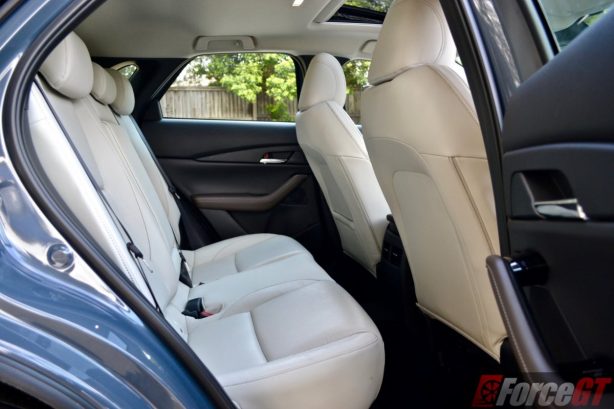

Both crossovers have nearly identical boot capacities, with the CX-30’s 317 litres of space only a litre less than the C-HR’s 318 litres. The rear seats in both vehicles can be folded to expand cargo space further, though in this arrangement the C-HR has a gap where the boot floor meets the rear seats while the CX-30’s is continuous throughout. The lower boot lip in the CX-30 also makes for easier loading.
In terms of technology, the CX-30’s pricier sticker gets you a head-up display (HUD), digital radio DAB+ and Bose premium audio with 12 speakers. The C-HR has none of those and makes do with a vanilla 6-speaker audio system. That said, a wireless phone charger is fitted to the Toyota but not the Mazda. While both cars have Apple CarPlay / Android Auto connectivity, phone pairing works quicker and better in the Toyota.
Safety wise, both crossovers are comprehensively fitted with Lane Keep Assist, Automatic High Beam, Adaptive Cruise Control, Forward Collision Warning, Autonomous Emergency Braking, Blind Spot Monitor and Road Sign Assist, Rear Cross Traffic Alert and surround view camera.
Under the skin
The CX-30 G25 is powered by a naturally aspirated 2.5-litre four-cylinder petrol engine developing 139kW @ 6000rpm and 252Nm @ 4000rpm. It’s paired with 6-speed automatic transmission with powered channeled to all four corners in our all-wheel drive variant.
The C-HR hybrid tested here is motivated by a 1.8-litre Atkinson cycle petrol engine assisted by an electric motor. Combined output is rated at 72kW @ 5200rpm and 142Nm @ 3600rpm, all of which go the front wheels via a CVT automatic.


Not surprising, the CX-30 wins hands down in terms of engine performance. Running on 13.0:1 high compression, the SkyActiv-G engine feels almost like turbo powered, with strong midrange torque affording it relatively effortless acceleration. It never feels underpowered, no matter the proceedings.
The petrol-electric hybrid in the C-HR feels inherently less punchy in comparison, even becoming a tad sluggish when you have a full load.
Both crossovers get off the line cleanly and swiftly, but it’s the Mazda that will continue to serve up waves of torque while the Toyota starts to lose puff at higher speeds.
Left to its own devices, the six-speed auto in the CX-30 shifts intelligently and is almost always in the right gear.
Meanwhile, there’s no escaping the ‘elastic’ feel of the CVT in the C-HR, but it does operate discretely in the background and is completely appropriate for an efficiency focused drivetrain.
On the road
The CX-30 and C-HR are some of the best handling cars in the segment. Both offer brilliant poise and composure that are very hatchback-like, though the CX-30 just edges a little in engagement with sharper responses and a livelier steering.
The CX-30 also has the advantage of all-wheel drive, offering better grip in wet conditions. That said, the C-HR’s chassis feels stiffer, and its wider tyres – 225 vs 215 – maintain traction just as well as the CX-30 in the dry.
Cruising at three-digit speeds on the freeway the C-HR also feels sturdier thanks to a heftier steering, while the CX-30’s lighter rack is more sensitive to small movement of the wheel.
Around town, the Mazda is certainly the more comfortable crossover to be in, with its softer set up delivering a more polished and refined ride quality. The Toyota’s sportier, firmer set up is still compliant but just not as plush over rougher surfaces.
The CX-30’s cabin is also better insulated from road noise, though the C-HR’s hybrid powertrain is much more muted.
In the long run
Both the CX-30 and C-HR come with the recently lengthened warranty of 5 years, with unlimited kilometre giving further assurance.
The Mazda requires a service at 10,000km or 12 months, while the Toyota is not due for one until 15,000km or 12 months.
Both cars are offered with capped price servicing, with the RAV4 capped at $195 per service for the first 5 years or 75,000km, and the CX-5 asking $316 for each dealer visit for the first 5 years or 50,000km. This makes the Toyota the cheaper car to maintain in the long term.
As expected, the C-HR will also yield more savings at the bowser, with its fuel efficient hybrid powertrain averaging just 4.6L/100km at the end of our week-long test, which is not far off the rated 4.3L/100km.
The CX-30’s larger engine is inherently thirstier, reporting an average of 7.9L/100km against the rated 6.8L/100km.
Both cars chew on less expensive RON 91 unleaded petrol.
Verdict
If you are in the market for a stylish, safe and reliable compact crossover, you can’t go wrong with either the Mazda CX-30 or Toyota C-HR. There’s much to like in both crossovers.
The CX-30 is a premium offering without a premium price tag. Combining classy styling with a plush cabin, the CX-30 packs a punchy powertrain and delivers a fine balance between ride and handling.
Costing less than the CX-30, the C-HR’s appeal lies with its hybrid efficiency and less expensive running costs.
But if budget permits, the more all-rounded CX-30 is the one to pick for it’s arguably the best the segment currently has to offer.
2020 Mazda CX-30 G25 Astina AWD | 2020 Toyota C-HR Koba Hybrid | |
| Design and Comfort | 9.0 | 7.5 |
| Performance and Handling | 8.5 | 8.0 |
| Quality | 8.5 | 8.0 |
| Economy | 7.5 | 9.0 |
| Equipment and Features | 8.0 | 7.5 |
| Overall | 42/50 | 40/50 |
Pricing and Specifications
2020 Mazda CX-30 G25 Astina AWD | 2020 Toyota C-HR Koba Hybrid | |
| Price (excluding on-road costs): | From $43,490 | From $37,190 |
| Warranty: | 5 years, unlimited km | 5 years, unlimited km |
| Warranty Customer Assistance: | 5 years roadside | Optional yearly plans |
| Service Intervals: | 12 months, 10,000km | 12 months, 15,000km |
| Country of Origin: | Japan | Japan |
| Engine: | 2.5-litre four-cylinder petrol: 139kW @ 6000rpm, 252Nm @ 4000rpm | 1.8-litre four-cylinder petrol hybrid with electric motor: 72kW @ 5200rpm, 142Nm @ 3599rpm |
| Transmission: | 6-speed automatic | CVT automatic |
| Drivetrain: | All-wheel drive | Front-wheel drive |
| Power-to-Weight Ratio (W/kg): | 94.2 | 62.7 |
| 0-100km/h (seconds): | 9.1 | N/A |
| Combined Fuel Consumption (L/100km): | Claimed: 6.8/Tested: 7.9 | Claimed: 4.3/Tested: 4.6 |
| RON Rating: | 91 | 91 |
| Fuel Capacity (L): | 48 | 43 |
| Body: | 5-door SUV, 5-seats | 5-door SUV, 5-seats |
| Safety: | 5-star ANCAP, 7 airbags, ABS, BA, EBD, ESC, Lane Departure Warning, Lane-Keep Assist System, Blind Spot Monitoring, Rear Cross Traffic Alert, Emergency Brake Assist, Emergency Stop Signal, Smart Brake Support, Smart City Brake Support, Driver Attention Alert, Traffic Sign Recognition, Head-Up Display (HUD), 360-degree view monitor, front and rear parking sensors, ISOFIX | 5-star ANCAP, 7 airbags, ABS, BA, EBD, ESC, Lane Departure Warning, Lane-Keep Assist System, Blind Spot Monitoring, Rear Cross Traffic Alert, Emergency Brake Assist, Emergency Stop Signal, Automatic Emergency Braking, Driver Attention Alert, Traffic Sign Recognition, 360-degree view monitor, front and rear parking sensors, ISOFIX |
| Dimensions (L/W/H/W-B): | 4,395/1,795/1,540/2,655 | 4,390/1,795/1,565/2,640 |
| Turning Circle Between Kerbs: | 10.6 | 10.4 |
| Kerb Weight (kg): | 1,544 | 1,460 |
| Entertainment: | 8.8-inch touchscreen infotainment system, satellite navigation, Bluetooth, USB, AUX, CD, AM/FM/DAB+, Apple CarPlay/Android Auto, 12-speaker BOSE stereo | 8.0-inch touchscreen infotainment system, satellite navigation, Bluetooth, USB, AUX, CD, AM/FM, Apple CarPlay/Android Auto, 6-speaker stereo |
 ForceGT.com Car News, Car Reviews, Video Reviews, Tuning and much more.
ForceGT.com Car News, Car Reviews, Video Reviews, Tuning and much more. 

